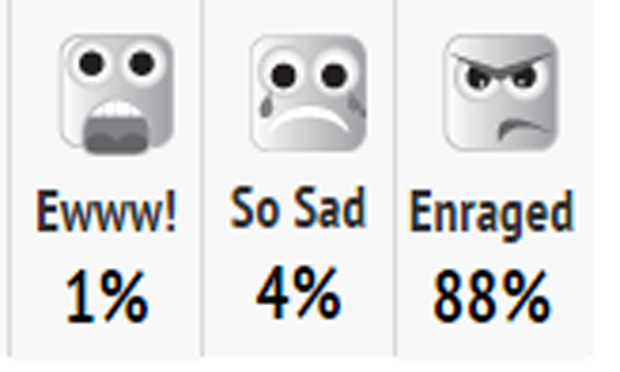Journalism is known for its mission to entertain and educate, which includes helping audience members understand the experiences of their fellow human beings. Often, news agencies forge this connection through emotion — by writing articles or creating broadcasts that, for example, generate compassion for someone struggling with a personal challenge or invoke anger about a group of people being treated unjustly. In today’s online landscape, news websites also rely on emotion to help drive web traffic. Newsroom leaders expect news items to be shared through e-mail and social media when audiences have emotional reactions to them. A 2012 study published in the Journal of Marketing Research suggests that online content that elicits intense emotions is more viral, regardless of whether those emotions are positive or negative.
Some news sites are helping readers find certain kinds of content by posting “mood meters” alongside news articles. These are visual displays of how readers describe their feelings about a particular piece. The Tampa Bay Times posts a bar at the bottom of each article inviting readers to click on words to describe their reactions to it. The bar also allows Tampa Bay readers to see how many other people chose symbols indicating that a story was inspiring, important, sad, angry or happy. A news startup called Rappler tracks reader emotions with eight description options and then promotes the stories that receive the most feeling “votes.” BuzzFeed encourages readers to identify its news items with labels such as “LOL,” “cute,” “fail,” and “OMG” and allows readers to access those types of items specifically.
How is this trend affecting audiences? Two researchers — Jessica Gall Myrick of Indiana University and Bartosz W. Wojdynski of the University of Georgia — sought to answer this question in their August 2015 study, “Moody News: The Impact of Collective Emotion Ratings on Online News Consumers’ Attitudes, Memory, and Behavioral Intentions.” Myrick and Wojdynski surveyed 298 people to determine how mood meters affected their reactions to a single human-interest story.
Key findings include:
- Participants who read the story without the presence of a mood meter reported feeling happier than did participants who saw a mood meter indicating negative responses to the story.
- Participants who read the story without the presence of a mood meter felt higher levels of emotion than did participants who read the article accompanied by mood meters indicating either positive reactions or negative reactions to the story.
- Participants remembered more content when no mood meter was present.
- The presence of a mood meter did not influence intent to share the news item.
The authors call this study a “first step” toward better understanding how user-generated ratings of emotion affect reader attitudes, memory and behavior. They recommend that future research includes multiple examples of human-interest stories as well as different types of news articles and that researchers use eye-tracking software to determine how much attention audiences give to mood meters. “As more news sites collect user evaluations and display them on story selection pages, it is important to examine whether these features may steer users toward or away from specific content, and how agency in choosing stories may influence how users’ evaluate those stories vis-à-vis mood meter data,” the researchers stated.
Related research: A 2015 study by two European researchers, “Deep Feelings: A Massive Cross-Lingual Study on the Relation between Emotions and Virality,” explores the link between reader emotion and the likelihood that certain news items will draw reader comments and elicit feedback through social media sites such as Facebook and Google Plus.
Keywords: social media, user-generated content, emotion, mood, human-interest stories, online news, memory, virality, crowdsourcing


Expert Commentary